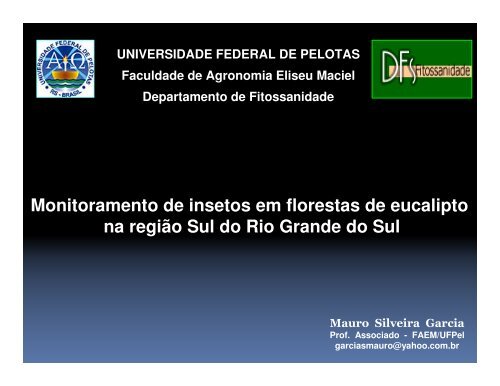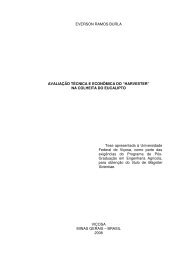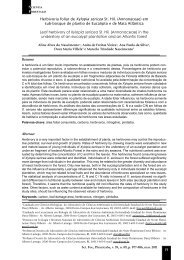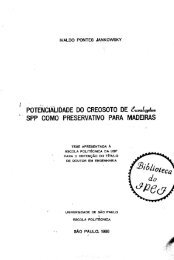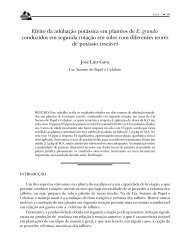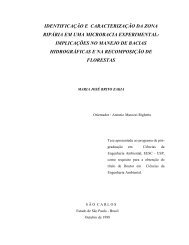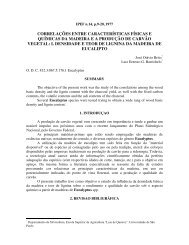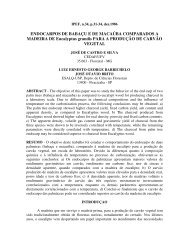Monitoramento de insetos em florestas de eucalipto na região ... - Ipef
Monitoramento de insetos em florestas de eucalipto na região ... - Ipef
Monitoramento de insetos em florestas de eucalipto na região ... - Ipef
You also want an ePaper? Increase the reach of your titles
YUMPU automatically turns print PDFs into web optimized ePapers that Google loves.
UNIVERSIDADE FEDERAL DE PELOTAS<br />
Faculda<strong>de</strong> <strong>de</strong> Agronomia Eliseu Maciel<br />
Departamento <strong>de</strong> Fitossanida<strong>de</strong><br />
<strong>Monitoramento</strong> <strong>de</strong> <strong>insetos</strong> <strong>em</strong> <strong>florestas</strong> <strong>de</strong> <strong>eucalipto</strong><br />
<strong>na</strong> <strong>região</strong> Sul do Rio Gran<strong>de</strong> do Sul<br />
Mauro Silveira Garcia<br />
Prof. Associado - FAEM/UFPel<br />
garciasmauro@yahoo.com.br
<strong>Monitoramento</strong> <strong>de</strong> <strong>insetos</strong> <strong>em</strong> <strong>florestas</strong> <strong>de</strong> <strong>eucalipto</strong> <strong>na</strong> <strong>região</strong> Sul do Rio Gran<strong>de</strong> do Sul<br />
INTRODUÇÃO<br />
OBJETIVOS<br />
Monitorar, através <strong>de</strong> armadilhas, a entomofau<strong>na</strong> ocorrente <strong>em</strong> reflorestamento<br />
com <strong>eucalipto</strong>;<br />
I<strong>de</strong>ntificar os <strong>insetos</strong> ocorrentes ao nível <strong>de</strong> família, gênero e/ou espécie;<br />
Estudar a flutuação populacio<strong>na</strong>l no <strong>de</strong>correr do ano e durante cinco anos;<br />
Aplicar os índices faunísticos aos dados coletados e tabulados.
<strong>Monitoramento</strong> <strong>de</strong> <strong>insetos</strong> <strong>em</strong> <strong>florestas</strong> <strong>de</strong> <strong>eucalipto</strong> <strong>na</strong> <strong>região</strong> Sul do Rio Gran<strong>de</strong> do Sul<br />
METODOLOGIA<br />
LOCAIS DE COLETA<br />
1. Município <strong>de</strong> Arroio Gran<strong>de</strong><br />
2. Município <strong>de</strong> Piratini<br />
3. Município <strong>de</strong> Pinheiro Machado<br />
4. Município <strong>de</strong> Candiota<br />
5. Município <strong>de</strong> Pedras Altas<br />
6. Município <strong>de</strong> Capão do Leão<br />
FAZENDA SANTA ROSA<br />
FAZENDA CERRO ALEGRE<br />
FAZENDA AROEIRA<br />
FAZENDA SÃO MANOEL<br />
FAZENDA SÃO FRANCISCO<br />
VIVEIRO
<strong>Monitoramento</strong> <strong>de</strong> <strong>insetos</strong> <strong>em</strong> <strong>florestas</strong> <strong>de</strong> <strong>eucalipto</strong> <strong>na</strong> <strong>região</strong> Sul do Rio Gran<strong>de</strong> do Sul<br />
METODOLOGIA<br />
Armadilhas<br />
Etanólica
<strong>Monitoramento</strong> <strong>de</strong> <strong>insetos</strong> <strong>em</strong> <strong>florestas</strong> <strong>de</strong> <strong>eucalipto</strong> <strong>na</strong> <strong>região</strong> Sul do Rio Gran<strong>de</strong> do Sul<br />
METODOLOGIA<br />
Armadilhas<br />
Etanólica<br />
Luminosa - mo<strong>de</strong>lo Intral (F15 T12 BL)
<strong>Monitoramento</strong> <strong>de</strong> <strong>insetos</strong> <strong>em</strong> <strong>florestas</strong> <strong>de</strong> <strong>eucalipto</strong> <strong>na</strong> <strong>região</strong> Sul do Rio Gran<strong>de</strong> do Sul<br />
METODOLOGIA<br />
Preparo do material para coleta<br />
Armadilha Luminosa<br />
Armadilha Etanólica
METODOLOGIA<br />
Triag<strong>em</strong>
METODOLOGIA<br />
Montag<strong>em</strong> <strong>de</strong> coleções e i<strong>de</strong>ntificação<br />
Museu Entomológico Ceslau Biezanko - Dr. Eduardo Ely e Silva<br />
Instituto Biológico <strong>de</strong> São Paulo - Dr. Sérgio I<strong>de</strong><br />
Instituto Biológico <strong>de</strong> Campi<strong>na</strong>s - Dr. Valmir Antônio Costa<br />
UNESP <strong>de</strong> Ilha Solteira - Dr. Carlos Alberto Hector Flechtmann
<strong>Monitoramento</strong> <strong>de</strong> <strong>insetos</strong> <strong>em</strong> <strong>florestas</strong> <strong>de</strong> <strong>eucalipto</strong> <strong>na</strong> <strong>região</strong> Sul do Rio Gran<strong>de</strong> do Sul<br />
EQUIPE<br />
01 Bolsista <strong>na</strong> área <strong>de</strong> sist<strong>em</strong>ática<br />
01 Bolsista <strong>de</strong> Mestrado<br />
04 Bolsistas <strong>de</strong> Iniciação Científica
<strong>Monitoramento</strong> <strong>de</strong> <strong>insetos</strong> <strong>em</strong> <strong>florestas</strong> <strong>de</strong> <strong>eucalipto</strong> <strong>na</strong> <strong>região</strong> Sul do Rio Gran<strong>de</strong> do Sul<br />
RESULTADOS
132<br />
ANÁLISE GERAL - FAZENDA SÃO MANOEL<br />
6673 <strong>insetos</strong> coletados <strong>em</strong> 466 espécies<br />
38<br />
4 3<br />
26<br />
Número <strong>de</strong> espécies coletadas <strong>na</strong>s or<strong>de</strong>ns mais representativas - 466<br />
5<br />
20<br />
238<br />
Lepidoptera Coleoptera H<strong>em</strong>iptera Diptera<br />
Hymenoptera Neuroptera Blatto<strong>de</strong>a Outras
ANÁLISE GERAL – IDENTIFICAÇÃO FAZENDA SÃO MANOEL<br />
Total 466 espécies<br />
174<br />
1<br />
77<br />
Nível Espécie Nível Gênero Nível Morfoespécie Somente Família Somente Or<strong>de</strong>m<br />
88<br />
126<br />
Número <strong>de</strong> <strong>insetos</strong> i<strong>de</strong>ntificados nos diferentes níveis
LEPIDÓPTEROS – FAZENDA SÃO MANOEL<br />
13<br />
49 6<br />
36<br />
Arctiidae Noctuidae Saturniidae Geometridae Sphingidae<br />
Número <strong>de</strong> espécies das famílias mais representativas <strong>de</strong> Lepidoptera (132)<br />
28
COLEÓPTEROS – FAZENDA SÃO MANOEL<br />
38<br />
10<br />
Cerambycidae Elateridae Scolytidae Scarabaeidae Carabidae<br />
Número <strong>de</strong> espécies das famílias mais representativas <strong>de</strong> Coleoptera (130 <strong>de</strong> 238)<br />
26<br />
41<br />
15
MAR ABR MAI JUN JUL AGO SET OUT NOV DEZ JAN FEV<br />
Nº 382 161 205 86 44 65 48 143 89 359 307 270<br />
°C 20,13 16,70 12,00 12,27 13,80 11,80 12,60 17,00 17,70 21,90 21,40 22,00<br />
mm 68,1 57,0 74,6 102,8 53,6 90,7 58,6 71,8 148,8 115,0 129,0 121,0
NOV DEZ JAN FEV MAR ABR MAI JUN JUL AGO SET OUT NOV<br />
Nº 41 15 81 27 269 100 119 24 0 48 95 46 429<br />
°C 17,90 21,00 22,00 21,20 20,13 17,70 12,00 12,27 13,80 11,80 12,60 17,00 17,7<br />
mm 5,7 42,6 89,8 44,9 68,1 57,0 74,6 102,8 53,6 90,7 58,6 71,8 148,8
(Coleoptera: Scolytidae)<br />
Tribos/Espécies<br />
Xyleborini LeConte, 1876<br />
Espécimes<br />
(nº)<br />
D * A F C<br />
Tricolus bifidus Schedl,1939 1 nd r pf z<br />
Xyleborus affinis Eichhoff, 1867 1 nd r pf z<br />
Xyleborus alter Eggers, 1931 3 nd c f z<br />
Xyleborus biconicus Eggers, 1928 2 nd c f z<br />
Xyleborus ferrugineus (Fabricius, 1801) 64 sd sa sf w<br />
Xyleborus gracilis Eichhoff,1868 7 d ma mf y<br />
Xyleborus linearicollis Schedl, 1937 72 sd sa sf w<br />
Xyleborus neivai Eggers, 1928 1 nd r pf z<br />
Xyleborus posticus Eichhoff, 1868 1 nd r pf z<br />
Xyleborus retusus Eichhoff, 1868 177 sd sa sf w<br />
Xyleborus sentosus Eichhoff, 1868<br />
Corthylini LeConte, 1876<br />
9 d ma mf w<br />
Corthylus anten<strong>na</strong>rius Schedl, 1966 58 sd sa sf w<br />
Corthylus nudipennis Schedl, 1950 3 nd c f y<br />
Corthylus sp. 15 d ma mf y<br />
Microcorthylus minimus Schedl, 1950 9 d ma mf y<br />
Microcorthylus sp. 1 nd r pf z<br />
Mo<strong>na</strong>rthrum brasiliensis (Schedl, 1936) 5 nd c f y<br />
Mo<strong>na</strong>rthrum sp.<br />
Cryphalini Lin<strong>de</strong>mann, 1976<br />
1 nd r pf z<br />
Cryptocarenus sp. 1 nd r pf z<br />
Hyphothen<strong>em</strong>us eruditus Westwood, 1836 4 nd c f y<br />
Hypothen<strong>em</strong>us bolivianus Eggers, 1931 1 nd r pf z<br />
Hyphothen<strong>em</strong>us sp. 1 nd r pf z<br />
Em que: D = Dominância: sd = superdomi<strong>na</strong>nte, d = domi<strong>na</strong>nte e nd = não-domi<strong>na</strong>nte.<br />
A = Abundância: sa = superabundante, ma = muito abundante, r = rara e c = comum.<br />
F = Freqüência: sf = superfrequente, mf = muito frequente, f = frequente e pf = pouco<br />
frequente. C = Constância: w = constante, y = acessória e z = aci<strong>de</strong>ntal.<br />
*Dominância: Método <strong>de</strong> Laroca e Mielke.
9 – espécies raras;<br />
4 – espécies superabundantes;<br />
4 – espécies muito abundantes;<br />
5 –espécies comuns;<br />
5<br />
FAZENDA SÃO MANOEL<br />
Análise faunística <strong>de</strong> abundância <strong>de</strong> Scolytidae mostra:<br />
4<br />
Raras Superabundantes Muito abundantes Comuns<br />
9<br />
4
Espécies<br />
Espécimes<br />
(nº)<br />
D* A F C<br />
Acantho<strong>de</strong>res jaspi<strong>de</strong>a (Germar, 1824) 23 d ma mf w<br />
Acantho<strong>de</strong>res nigricans Lameere, 1885 3 nd d pf z<br />
Achryson suri<strong>na</strong>mum (Lin<strong>na</strong>eus, 1767) 3 nd d pf y<br />
Centrocerum elegans (Chevrolat, 1861) 2 nd r pf z<br />
Chlorida costata Audinet -Seville, 1834 23 d ma mf w<br />
Chlorida festiva Linneus, 1758 7 d c f y<br />
Chydarteres striatus striatus (Fabricius, 1787) 8 d c f w<br />
Compsoceridius gounelle (Bruch, 1908) 1 nd r pf z<br />
Compsocerus barbicornis Audinet -Serville, 1834 45 d ma mf w<br />
Compsocerus violaceus (White,1853) 2 nd r pf z<br />
Dorcadocerus barbatus (Olivier, 1790) 1 nd r pf z<br />
Eburodacris sp. 20 d ma mf w<br />
Erosida lineola (Fabricius, 1781) 2 nd r pf z<br />
Mallocera glauca Audinet -Serville,1833 1 nd r pf z<br />
Eurysthea hirta (Berg, 1889) 20 d ma mf w<br />
Eurysthea lacordairei (Lacordaire, 1869) 1 nd r pf z<br />
Hippopsis sp. 1 nd r pf z<br />
Hyperplatys argentinus (Berg, 1889) 2 nd r pf z<br />
Leptostylus obscurellus Bates, 1863 1 nd r pf z<br />
Lypsime<strong>na</strong> nodipennis (Burmeister) 4 nd d pf z<br />
Martinsellus sig<strong>na</strong>tus (Gyllenhal, 1817) 1 nd r pf z<br />
Megacyllene acuta (Germar, 1821) 5 nd c f y<br />
Nealcidion bicristatum (Bates, 1863) 2 nd r pf z<br />
Neoclytus centurio (Chevrolat, 1862) 17 d a mf y<br />
Neoclytus curvatus (Germar, 1821) 270 sd sa sf w<br />
Neoclytus pusillus (Laporte & Gory, 1836) 16 d c f y<br />
Neoclytus ypsilon Chevrolat, 1865 16 d c f y<br />
Neodillonia adspersa (Germar, 1824) 1 nd r pf z<br />
Nyssodrysi<strong>na</strong> lig<strong>na</strong>ria (Bates, 1863) 102 d ma mf w<br />
Oreo<strong>de</strong>ra r<strong>em</strong>ota (Pascoal, 1859) 1 nd r pf z<br />
Oxymerus luteus luteus (Voet,1778) 3 nd d pf y<br />
Paramoecerus barbicornis (Fabricius, 1792) 11 d c f y<br />
Phoracantha recurva Newman, 1840 1 nd r pf z<br />
Retrachy<strong>de</strong>res thoraxicus (Olivier, 1790) 13 d c f w<br />
Thelgetra latipennis Thomson, 1864 1 nd r pf z<br />
Unxia gracilior (Burmeister, 1865) 2 nd r pf z<br />
Em que: D = Dominância: sd = superdomi<strong>na</strong>nte, d = domi<strong>na</strong>nte e nd Cerambicí<strong>de</strong>os<br />
= não-domi<strong>na</strong>nte.<br />
A = Abundância: sa = superabundante, ma = muito abundante, r Fazenda = rara e c São = comum. Manoel<br />
F = Freqüência: sf = superfrequente, mf = muito frequente, f = frequente e pf = pouco<br />
frequente. C = Constância: w = constante, y = acessória e z = aci<strong>de</strong>ntal.<br />
*Dominância: Método <strong>de</strong> Laroca e Mielke.<br />
36 ESPÉCIES IDENTIFICADAS<br />
DE UM TOTAL DE 41<br />
ESPÉCIES COLETADAS
FAZENDA SÃO MANOEL<br />
Análise faunística <strong>de</strong> abundância <strong>de</strong> cerambycidae mostra:<br />
1 espécie superabundante (44% dos cerambyci<strong>de</strong>os)<br />
6 espécies muito abundantes (38% dos cerambycidae)<br />
4 espécies dispersas<br />
7 espécies comuns<br />
18 espécies raras (com no máximo 2 espécimens) (aprox. 50% espécies)
1.167 <strong>insetos</strong> coletados<br />
31 espécies coletadas todas i<strong>de</strong>ntificadas<br />
Scolytidae - Fazenda Cerro Alegre<br />
6%<br />
2%<br />
76%<br />
2%<br />
3%<br />
11%<br />
Xyleborus ferrugineus Corthylus anten<strong>na</strong>rius<br />
Xyleborus retusus Xyleborus linearicollis<br />
Hypothenomus eruditus Outras<br />
Espécies mais representativas <strong>de</strong> Scolytidae
330 <strong>insetos</strong> coletados<br />
27%<br />
Scolytidae - Fazenda São Manoel<br />
40 espécies coletadas todas i<strong>de</strong>ntificadas<br />
18%<br />
18%<br />
Xyleborus ferrugineus Corthylus anten<strong>na</strong>rius Xyleborus retusus<br />
Xyleborus linearicollis Hypothen<strong>em</strong>us eruditus Xyleborus sentosus<br />
Corthylus sp.<br />
8%<br />
25%<br />
Espécies mais representativas <strong>de</strong> Scolytidae.<br />
2%<br />
2%
Arctiidae<br />
Fazenda São Manoel<br />
Espécies<br />
Espécimes<br />
(nº)<br />
D* A F C<br />
Agoraea s<strong>em</strong>ivitrea Rotsch, 1909 1 nd d pf z<br />
Agylla argentifera (Walker, 1866) 49 d ma mf w<br />
Biturix rectilinea (Burmeister, 1878) 26 d ma mf y<br />
Dyssch<strong>em</strong>a cente<strong>na</strong>ria (Burmeister, 1878) 1 nd d pf z<br />
Dyssch<strong>em</strong>a hilari<strong>na</strong> (Weyner, 1914) 4 nd c f y<br />
Dyssch<strong>em</strong>a sacrigisa (Hübner, 1831) 1 nd d pf z<br />
Eurota hele<strong>na</strong> (Herrich-Schäffer, 1854) 5 nd c pf z<br />
Eurota herricki Butter, 1876 10 d c f y<br />
Hypercompe <strong>de</strong>tecta (Obterthür, 1881) 1 nd d pf z<br />
Hypercompe in<strong>de</strong>cisa (Walker, 1855) 2 nd d pf z<br />
Hypercompe kinkelini (Burmeister, 1880) 3 nd d pf y<br />
Hypidalia enervis (Schaus, 1894) 2 nd d pf z<br />
Idalus mo<strong>na</strong>stidza (Hampson, 1916) 1 nd d pf z<br />
Leucanopsis leucani<strong>na</strong> (Fel<strong>de</strong>r & Rogenhofer, 1874) 5 nd c pf z<br />
Lophocampa dinora (Schaus, 1855) 2 nd d pf z<br />
Lophocampa texta (Herrich-Shaffer, 1855) 1 nd d pf z<br />
Melesa castri<strong>na</strong> Schaus, 1905 7 d c f y<br />
Opharus r<strong>em</strong>a (Dognin, 1891) 3 nd d pf y<br />
Paracles azollae (Berg, 1877) 26 d ma mf y<br />
Paracles cajetani (Rothschild, 1910) 115 d ma mf w<br />
Paracles fusca (Walker, 1856) 22 d ma mf w<br />
Paracles pallidive<strong>na</strong> (Schaus, 1904) 4 d ma mf w<br />
Paracles paula (Schaus, 1896) 2 nd d pf z<br />
Paracles variegata (Schaus, 1904) 3 nd d pf y<br />
Pelochyta cinerea (Walker,1855) 4 d ma mf w<br />
Philoros affinis (Rothschild, 1912) 37 d ma mf w<br />
337 <strong>insetos</strong> coletados <strong>em</strong> 28 espécies e todas i<strong>de</strong>ntificadas
Geometridae - Fazenda São Manoel<br />
Espécies<br />
Espécimes<br />
(nº)<br />
D* A F C<br />
Acrotomo<strong>de</strong>s sp. 1 4 nd ma mf w<br />
Acrotomo<strong>de</strong>s sp. 2 2 nd c f z<br />
Acrotomo<strong>de</strong>s sporadata Warren, 1905 1 nd r pf z<br />
Bryoptera sp. 2 nd c f z<br />
Hymenomima amberia (Schaus, 1901) 5 d ma mf w<br />
Iridopis lurida (Schaus, 1918) 1 nd r pf z<br />
Lissochlora nortia (Druce, 1892) 2 nd c f z<br />
Lomographa nubimargo Warren, 1897 2 nd c f z<br />
Macaria regulata (Fabricius, 1775) 2 nd c f z<br />
Oospila pallidaria Schaus, 1898 2 nd c f z<br />
Oxydia chalybeata Warren, 1897 1 nd r pf z<br />
Oxydia peosi<strong>na</strong>ta Guenée, 1858 8 d ma mf w<br />
Pero gonopteraria (Guenée, 1858) 9 d ma mf w<br />
Pero hoedularia (Guenée, 1858) 1 nd r pf z<br />
Pero refellaria (Guenée, 1858) 3 d c f z<br />
Pero sp. 1 3 d c f y<br />
Pero sp. 2 1 nd r pf z<br />
Pero sp. 3 1 nd r pf z<br />
Pherotesia con<strong>de</strong>nsaria (Guenée, 1858) 1 nd r pf z<br />
Phrygionis mo<strong>de</strong>sta Warren, 1904 4 nd ma mf w<br />
Physocleora fusca Warren, 1897 2 nd c f z<br />
Physocleora philaria (Guenée, 1858) 1 nd r pf z<br />
Prochoero<strong>de</strong>s tetrago<strong>na</strong>ta Guenée, 1858 3 d c f y<br />
Sabulo<strong>de</strong>s exhonorata Guenée, 1858 1 nd r pf z<br />
Synchlora frondaria Guenée, 1857 4 nd ma mf w<br />
Tachypyle oliva (Schaus, 1901) 4 nd ma mf w<br />
180 <strong>insetos</strong> coletados <strong>em</strong> 52 espécies sendo 26 i<strong>de</strong>ntificadas
Noctuidae - São Manoel<br />
Espécies<br />
Espécimes<br />
(nº)<br />
Agrotis gypacti<strong>na</strong> Gueéne, 1852 9<br />
Agrotis malefida Guenée, 1852 40<br />
Anicla infecta (Ochsenheimer, 1816) 10<br />
Faronta albilinea (Hübner, 1821) 14<br />
Leucania jabisca<strong>na</strong> Schaus, 1898 24<br />
Ochropleura cirphisioi<strong>de</strong>s Köheler, 1955 59<br />
Pseudoleucania tendiliense (Köhler, 1955) 131<br />
Rachiplusia nu (Guenée, 1852) 10<br />
Tripseuxoa strigata Hampson, 1903 52<br />
428 <strong>insetos</strong> coletados <strong>em</strong> 50 espécies – todas i<strong>de</strong>ntificadas
GEOMETRIDEOS PRAGA DO EUCALIPTO<br />
Sabulo<strong>de</strong>s caberata caberata<br />
Oxydia sp.<br />
AMBAS COLETADAS NA FAZENDA CERRO ALEGRE<br />
POUCOS EXEMPLARES
PSILÍDEO DO EUCALÍPTO NA REGIÃO SUL:<br />
I<strong>de</strong>ntificação, bioecologia e controle biológico
PSILÍDEO DO EUCALÍPTO NA REGIÃO SUL: I<strong>de</strong>ntificação, bioecologia e controle biológico<br />
INTRODUÇÃO<br />
Psilí<strong>de</strong>o-<strong>de</strong>-concha Glycaspis brimblecombei (H<strong>em</strong>iptera: Psyllidae)<br />
Cte<strong>na</strong>rytai<strong>na</strong> spatulata (H<strong>em</strong>iptera,<br />
Psyllidae)<br />
Cte<strong>na</strong>rytai<strong>na</strong> eucalypti (Maskell) (H<strong>em</strong>.: Psyllidae)
PSILÍDEO DO EUCALÍPTO NA REGIÃO SUL: I<strong>de</strong>ntificação, bioecologia e controle biológico
PSILÍDEO DO EUCALÍPTO NA REGIÃO SUL: I<strong>de</strong>ntificação, bioecologia e controle biológico<br />
Cte<strong>na</strong>rytai<strong>na</strong> eucalypti (Maskell) (H<strong>em</strong>.: Psyllidae)<br />
DANOS
PSILÍDEO DO EUCALÍPTO NA REGIÃO SUL: I<strong>de</strong>ntificação, bioecologia e controle biológico<br />
<strong>Monitoramento</strong><br />
Cte<strong>na</strong>rytai<strong>na</strong> spatulata
PSILÍDEO DO EUCALÍPTO NA REGIÃO SUL: I<strong>de</strong>ntificação, bioecologia e controle biológico<br />
<strong>Monitoramento</strong><br />
<strong>Monitoramento</strong> da área 1 - E. globulus<br />
Cte<strong>na</strong>rytai<strong>na</strong> eucalypti
PSILÍDEO DO EUCALÍPTO NA REGIÃO SUL: I<strong>de</strong>ntificação, bioecologia e controle biológico<br />
<strong>Monitoramento</strong><br />
Cte<strong>na</strong>rytai<strong>na</strong> spatulata
PSILÍDEO DO EUCALÍPTO NA REGIÃO SUL: I<strong>de</strong>ntificação, bioecologia e controle biológico<br />
<strong>Monitoramento</strong><br />
Cte<strong>na</strong>rytai<strong>na</strong> eucalypti
Cte<strong>na</strong>rytai<strong>na</strong> spatulata<br />
Cte<strong>na</strong>rytai<strong>na</strong> spatulata
<strong>Monitoramento</strong> da área 1 - E. globulus<br />
Cte<strong>na</strong>rytai<strong>na</strong> eucalypti<br />
Cte<strong>na</strong>rytai<strong>na</strong> eucalypti
PSILÍDEO DO EUCALÍPTO NA REGIÃO SUL: I<strong>de</strong>ntificação, bioecologia e controle biológico<br />
Cte<strong>na</strong>rytai<strong>na</strong> eucalypti (Maskell) (H<strong>em</strong>.: Psyllidae)<br />
Controle biológico<br />
Psyllaephagus pilosus Noyes (Hym.: Encyrtidae)
UNIVERSIDADE FEDERAL DE PELOTAS<br />
Faculda<strong>de</strong> <strong>de</strong> Agronomia Eliseu Maciel<br />
Departamento <strong>de</strong> Fitossanida<strong>de</strong><br />
<strong>Monitoramento</strong> <strong>de</strong> <strong>insetos</strong> <strong>em</strong> <strong>florestas</strong> <strong>de</strong> <strong>eucalipto</strong><br />
<strong>na</strong> <strong>região</strong> Sul do Rio Gran<strong>de</strong> do Sul<br />
Mauro Silveira Garcia<br />
Prof. Associado - FAEM/UFPel<br />
garciasmauro@yahoo.com.br


